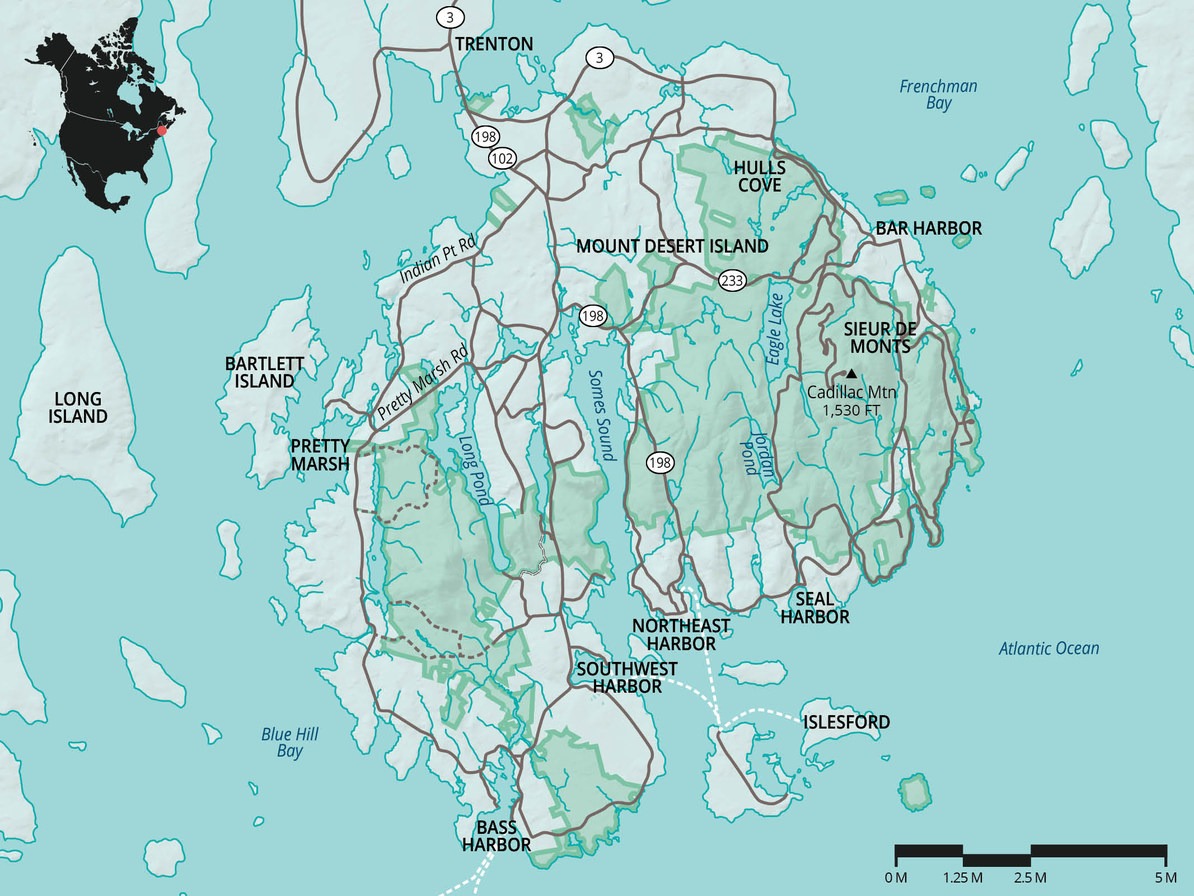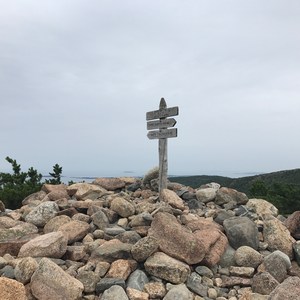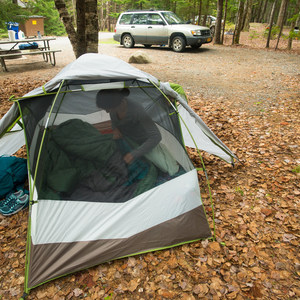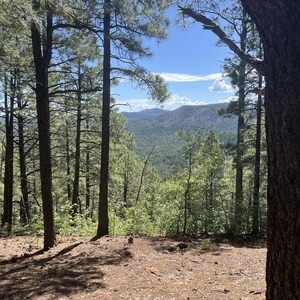You are here
Acadia National Park Overview | Activities | Camping | Weather | Pets
Acadia National Park Overview
Over 40 miles of coastline and nearly 48,000 acres of land comprise Acadia National Park, nestled at the very top of New England. The park is unique in its geography (spanning several islands) and representative of all the charm typical of New England landscapes: rugged coastlines, thick pine forests, and wildlife that lives just on the edge of cool Atlantic Ocean spray.
Known as “the first national park east of the Mississippi,” Acadia was first established as a national park in 1916 by President Woodrow Wilson (but more officially in 1919) and only renamed Acadia in 1929. The name is thought to come from “Arcadia,” a region in Greece that a famous explorer was reminded of when he first sailed by the Maine isles in 1524.
Unlike other national parks, Acadia is made up of fragmented pieces of protected land that span several islands and coastal regions, the largest of which being on Mount Desert Island, followed by Schoodic Peninsula and Isle Au Haut. Protected lands can also be found on Baker Island and Bar Island. On Mount Desert Island’s east side sits the area’s biggest tourist destination: Bar Harbor. Often crowded with foot traffic entering and leaving docked cruise ships, the small town is a hub for small eateries and gift shops.

There are 26 peaks in Acadia, ranging from 284 feet to roughly 1,500 feet. Cadillac (1,530 feet) is the highest, followed by Sargent (1,373) and Dorr (1,270). Over 120 miles of diverse trails can be found within the park. Other common outdoor activities include horseback riding (on the 45 miles of Carriage Roads), cycling, climbing (on sea cliffs near Otter Point and Great Head), boating, and fishing.
The park is also known for birdwatching, and some of the best places to spot these distinct species include Sieur de Monts Spring Area and Precipice, where visitors can see peregrine falcons nesting cliff-side April-August.
The beaches of Acadia are characteristically rocky and covered in cobblestones, with the exception of Sand Beach (covered in rough sand made of finely ground shells). Large granite boulders and cliffs can be found throughout the park and along the coastline, with the most impressive sea cliffs located near Otter Point. The forests in the park are a true blend, featuring both spruce-firs typically found in northern regions as well as hardwood trees found throughout New England. The park contains an abundance of large and small ponds, as well as marshy wetland areas that partially serve as habitats to more than 300 species of birds.
Activities
Hiking in Acadia ranges from easy walks down near-paved paths, to scaling the side of granite cliffs, clinging only to bolted metal ladders. Most hikes in Acadia will take visitors through a variety of landscapes, often leading for miles through pine forests to tranquil ponds and meadows or impressive seaside cliffs. While backcountry camping is not permitted in the park, trails on the Isle au Haut or those requiring steep ascents will offer the most seclusion for day hikers.
- Jesup Path: 2-mile out-and-back along boardwalk paths with ocean views.
- Cadillac Summit: Steep-ish trail hike to the top of Cadillac Mountain.
- Otter Point: Seaside hike featuring pink granite rock formations.
- Jordan Pond: 1-mile loop through forests to the pond.
- Ocean Path: 2-mile rugged coastal trail.
- Wonderland: 1.4-mile hike from forests to rocky coastlines.
- Bar Island: Hike the sand bar leading to this forest island. Check tide schedules in advance for access.
- Carriage Roads: Walk (or ride) the 45 miles of Carriage Roads throughout the park.
- Ship Harbor: 1.8-mile loop trail, ideal for bird-watching and other wildlife sightings.
- Beech Cliff Trail: A hike that begins at Echo Lake, with light climbing on ladders throughout.
- Beech Mountain: Mixed hike and scramble to the historic fire tower atop Beech Mountain.
- Cadillac Mountain South Ridge Trail: 7-mile hike from sea level to summit.
- Cadillac Mountain North Ridge Trail: 4.4-mile ascent with views of Bar Harbor.
- Precipice Trail: The most direct ascent of Cadillac Mountain, this steep climb is one of the most exciting hikes in Acadia.
- The Gorge Path: Stroll through old-growth forest and beside a stream as you make your ascent of two of the park's highest points, Cadillac Mountain and Dorr Mountain.
- Gorham Mountain Trail: Steep climb that can be paired with other trails for distance.
- Champlain Mountain via South Ridge Trail: Hike Acadia's second highest peak on this 5-mile trail.
- Great Head Trail: 1.4 miles of Sea Cliffs on the eastern side of Sand Beach.
- Beehive Loop Trail: A short, high-adventure ascent with ladder climbing and scrambling.
- Great Head Loop: This short loop near the Beehive Loop offers some amazing views along its 2-mile length. Hikers should be prepared to remove their shoes to cross a small waterway.
- Dorr Mountain: 4.8-mile climb along granite paths.
- Precipice Trail: Extreme 1.6-mile hike involving a 1,000 feet vertical climb on ladders.
- Mansell Mountain: 2-mile hike featuring rocky stairs and pond views on Mount Desert Island.
- Acadia Mountain Trail: 2.5-mile steep climb with 700 feet of elevation gain and views of Southwest Harbor.
- Pemetic Mountain: 2.4-mile trail alternating between forest and ocean landscapes.
- Norumbega Mountain: 1-mile steep ascent in a forest setting.
Camping
Camping in Acadia almost always requires advanced planning. Because the park does not issue backwoods permits, even primitive sites fill up quickly during the busy season. A number of campgrounds and resorts are also available just outside the park, offering RV camping, cabins, and more extensive amenities like heated pools.
-
Blackwoods Campground: A variety of campsites are available year-round, with some exceptions.
-
Seawall Campground: Located south of Southwest Harbor. Primitive sites, tent sites, and RV sites available.
-
Schoodic Wood Campground: Located southeast of Winter Harbor. Primitive sites, tent sites, and RV sites available.
-
Duck Harbor Campground: Five primitive campsites on the Isle au Haut, accessible only by boat.
-
Wildwoods Stable Camping: Available only to those visiting with horses.
Weather
Acadia is in the Northeast, which means the weather is usually anyone’s guess. Winters are relatively cold (with temperatures typically around 30 degrees Fahrenheit), and summer temperatures tend to be cool along the coast (mid to high 60s), getting warmer as you move inland. Fog often covers mountain peaks with varying degrees of visibility. Humidity levels still tend to be relatively high during the summer, and dressing in lightweight layers (with some sort of wind protection for higher altitudes and seaside jaunts) is recommended.
Pets
Pets are mostly permitted in the park, but with several restrictions. Pets must be kept on a leash at all times, and should not be left unsupervised. Blackwoods, Seawall and Schoodic Woods campgrounds allow pets; dogs are only permitted on Isle Haut for day hiking (not camping).
Several trails are closed to pets, including: Precipice, Beehive, Ladder Trail to Dorr Mountain, Beech Cliffs Trail, Perpendicular Trail (Mansell Mountain), and Jordan Cliffs Trail (between Penobscot East and carriage road). The Wild Gardens of Acadia, as well as Sand Bach and Echo Beach are closed to pets.
Dogs are not allowed to swim in most lakes throughout the park (but neither are people) as the lakes serve as drinking water sources for locals. Several trails are listed by park rangers as “not recommended” for pets, likely due to the scramble-climbing nature of certain hikes.









Comments
Sign In and share them.